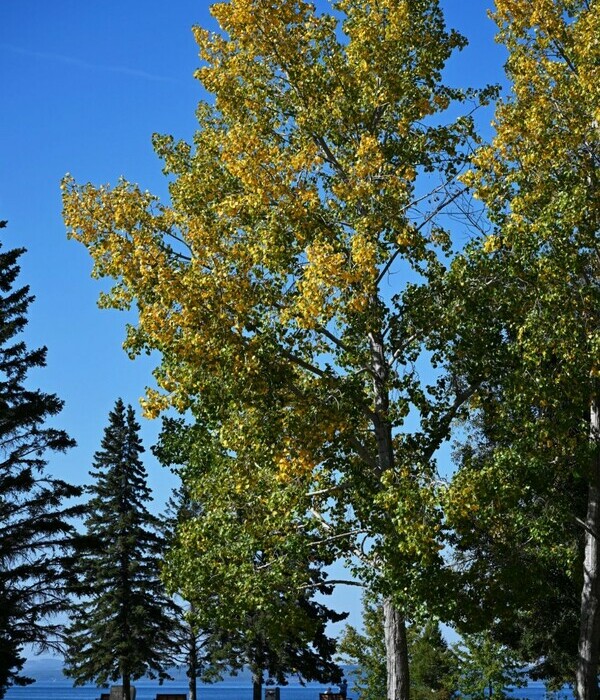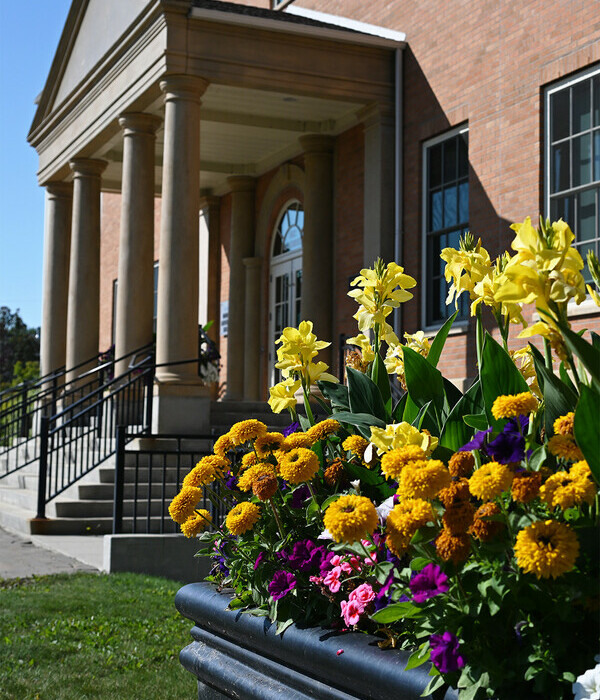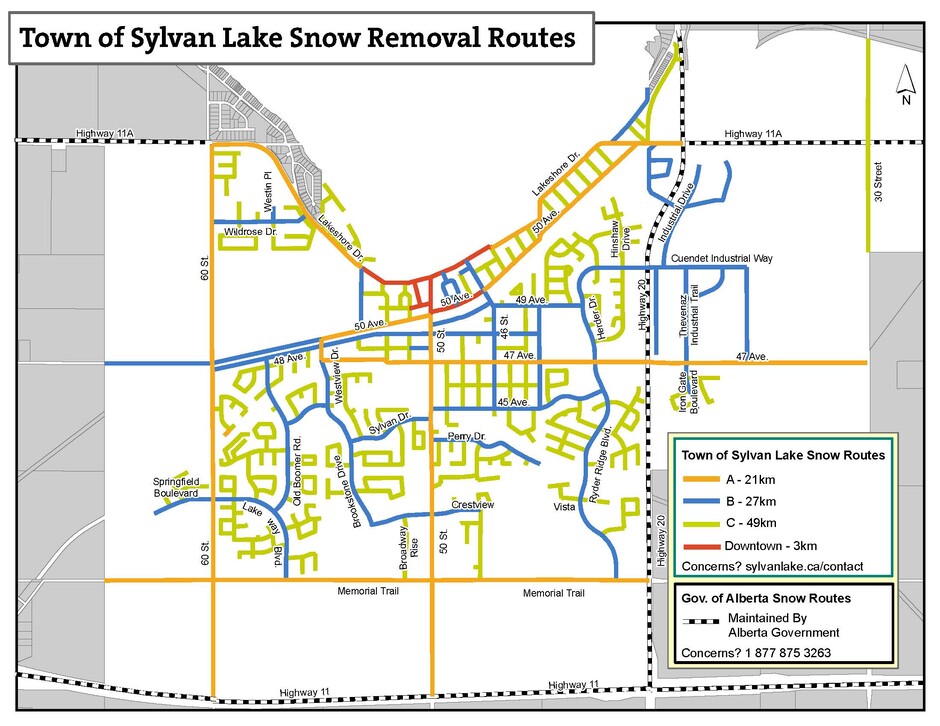What to expect during snow removal
Schedules
- Equipment problems, weather, or other problems may cause snow removal schedules to change
No parking signs
- No parking signs go up 24 hours before snow removal
- No parking remains in effect 24 – 72 hours after the signs are up
- To allow snow removal to continue, parked vehicles are tagged and towed at the owner’s expense
How do we decide how often to remove snow?
Plowing costs money. The more we plow the roads, the higher our taxes must be. We work hard to balance snow removal with the responsible management of your tax dollars.
How do we decide which roads to plow first?
We plow the busiest roads first. This keeps traffic flowing and makes sure emergency services have access to all parts of town.
- A routes: these arterial roads are the priority because they carry the most traffic
- B routes: roads that connect arterials to residential routes come next
- C routes: these residential roads carry the least amount of traffic. We understand how frustrating snowstorms can make getting in and out of our homes, but the priority must always fall with roads carrying the most traffic
How do I know when my street will be plowed?
- Subscribe for email snow removal notices by selecting Snow Removal
Snow removal at-a-glance
Routes and walkways
The Town of Sylvan Lake maintains most roads in Sylvan Lake:
- Questions? Submit it through our online form and under Public Works select Streets (damage/safety/snow/ice)
Some roads in and around Sylvan Lake are maintained by the Government of Alberta:
- Hwy 11
- Hwy 20 (including intersections)
- Hwy 11a (including the roundabout at Hwy 20)
- For questions about these routes, call 1 877 875 3263
- Sometimes we clear sections of streets. We will return to clear the remainder later
- Snow piled in cul-de-sacs is removed within seven days
- Driveways blocked with snow are cleared within one hour
- Windrows in the centre of roads are removed within three days
Remember, equipment problems, weather, or other problems may cause snow removal schedules to change
No parking signs
- No parking signs go up 24 hours before snow removal
- No parking remains in effect 24 – 72 hours after the signs are up
- To allow snow removal to continue, parked vehicles are tagged and towed at the owner’s expense
Notifications
- Subscribe for email snow removal notices by selecting Snow Removal
- Notices are shared on Facebook and Twitter. Please keep in mind that social media does not always share every post to every person
On most roads, snow is ploughed from the sidewalk side of the road to the Town owned municipal boulevard on the curb side of the road.
Why are some windrows placed on municipal boulevards (at the foot of residential properties) after plowing?
- Hauling snow away after it is plowed is expensive
- It costs less to sweep the gravel in the spring for removal and recycling
- When the snow melts in the spring, any gravel left on the boulevard is swept onto the road by public works during the street sweeping program
Municipal boulevards are:
- Not a road or street
- A strip of property owned by the Town
- Where the Town stores snow in the winter
- Swept of debris each spring by the Town
- A shared responsibility (property owners must, within 48 hours of a snowfall, remove and clear away snow and ice from from any sidewalks adjacent to their property)
Where are boulevards located?
- Most often a 3.25 m strip between the road and where private property begins
- This measurement may change depending on the neighbourhood and property
- The boulevard can include:
- No curb
- A curb
- A sidewalk and a curb, or
- A sidewalk, landscaping, and a curb
How do I know where the edge of my property meets the boulevard?
- You can check a real property report for an accurate measurement
- For a rough estimate, measure 3.5 m back from the edge of the road
Can I use the municipal boulevard?
- No. The municipal boulevard is the property of the Town
- Municipal boulevards are for snow storage
- Do not place any landscaping or items that can be damaged by snow storage or street sweeping in the boulevard
We sand as required:
- Wherever a change of speed or direction is likely to occur
- At known problem areas such as hills, rail crossings, and schools
- Major arterial roads, and downtown business core
- We haul snow, as required, from these routes
- We clear windrows that block driveways, mailboxes, fire hydrants, or crosswalks within one hour
- We make every attempt to meet the windrow removal time
- May be subject to staffing levels and weather events
A route triggers
- First priority: because they carry the highest volume of traffic
- Trigger: 8 cm loose/5 cm packed snow
- Target start: 48 hours
- Target completion: 96 hours
- Residential roads that connect residential to arterial routes, for example Old Boomer Road
- Snow is stored, then hauled, as required, along these routes
- We clear windrows that block driveways, mailboxes, fire hydrants, or crosswalks within one hour
- We make every attempt to meet the windrow removal time.
- May be subject to staffing levels and weather events
B route triggers
- Second priority: carry less traffic than A routes
- Trigger: 8 cm loose/8 cm packed snow
- Target start: 72 hours
- Target completion: 120 hours
- All remaining local/residential roads
- Most snow is stored; some hauling occurs on roadways with minimal snow storage available, such as cul-de-sacs, or roads that are impassable due to diminishing road width
- We clear windrows that block driveways, mailboxes, fire hydrants, or crosswalks within one hour
- We make every attempt to meet the windrow removal time. However, it may be subject to staffing levels and weather events
- On average, we plough these routes twice a year
C route triggers and targets
- Third priority: because these routes carry the lowest volume of traffic
- Trigger: Every 45 cm seasonal accumulation or 30 cm in a single snow event. A seasonal trigger also exists, at the discretion of the Director
- Target start: 7 days
- Target completion: 16 days
- Roads within the downtown core
- Snow is hauled from these roadways
Downtown route triggers and targets
- Trigger: 5 cm packed snow
-
Target start: 72 hours
- Target completion: 96 hours
- Any back lane that provides rear access to properties
- Alleys used as the primary access to a dwelling, are inspected more often, and cleared as required
- For example, properties that parallel Lakeshore Drive, or secondary suites
Alley triggers and targets
- Done as required when practical to do so
- Alleys are allowed to pack
- When plowed, loose snow is removed down to the snow pack
Walkways at public facilities triggers and targets
- Trigger: 3 cm loose/8 cm packed snow
-
Target start: 24 hours
- Target completion: 96 hours
- Walkways that are adjacent to Town facilities, trails, and designated pedestrian corridors
A walkway triggers and targets
- Trigger: 3 cm accumulation
-
Target start: 24 hours
- Target completion: 96 hours
- Walkways that are adjacent to parks, and utility right-of-way
B Walkway triggers and targets
-
Trigger: 3 cm accumulation
-
Target start: 48 hours
-
Target completion: 120 hours




